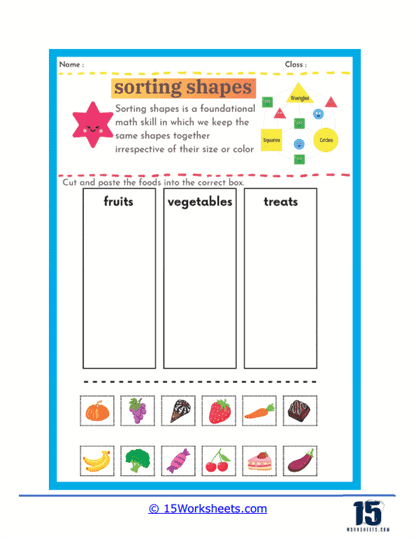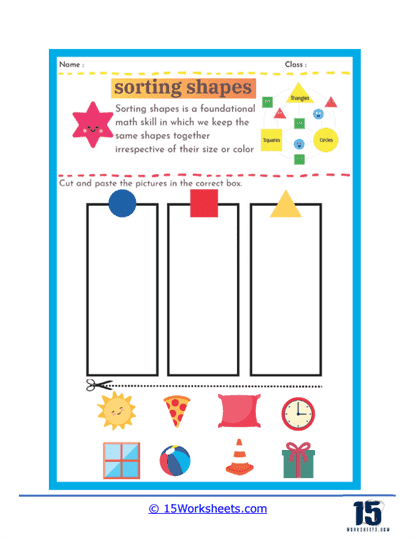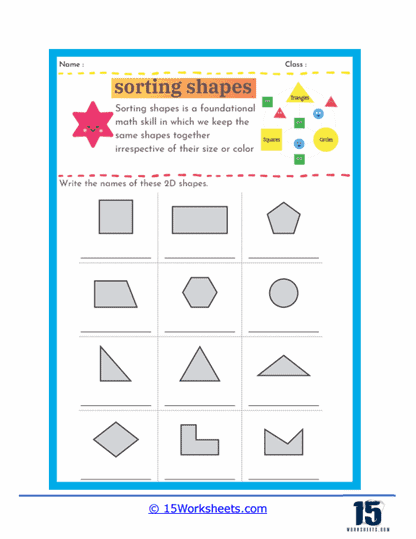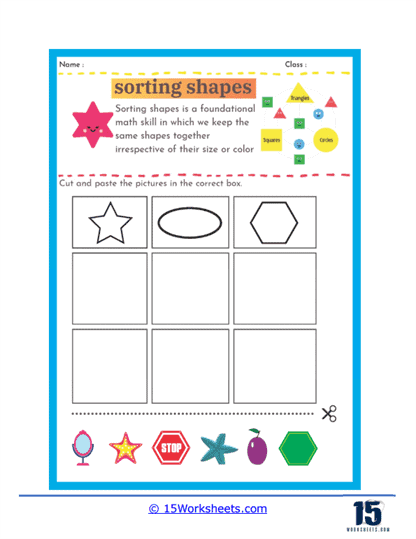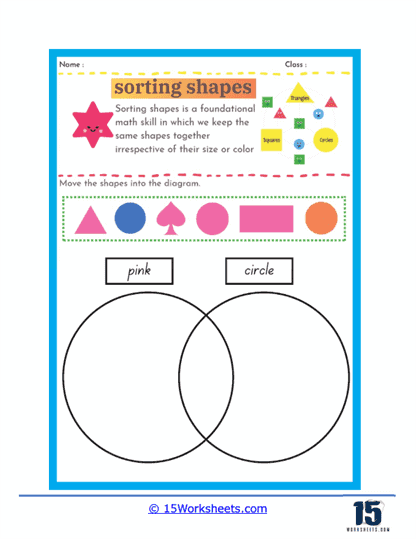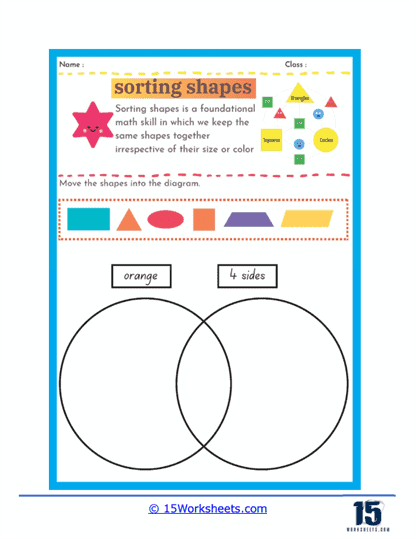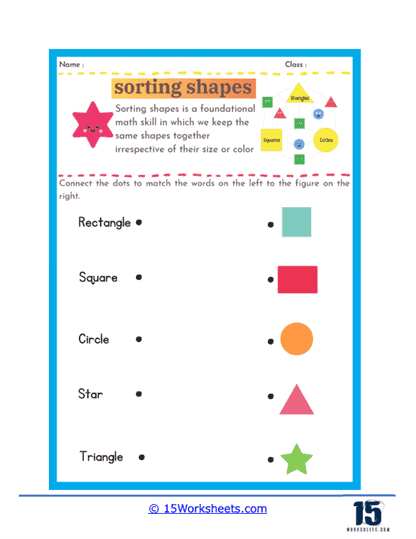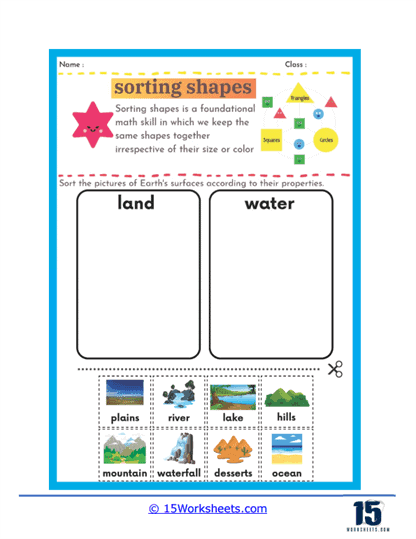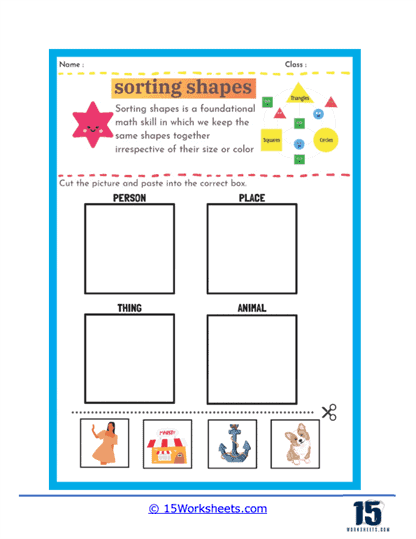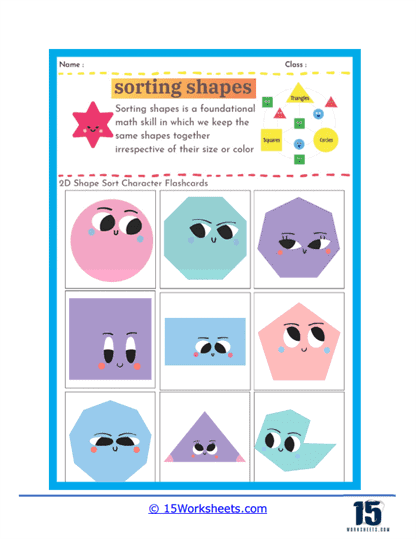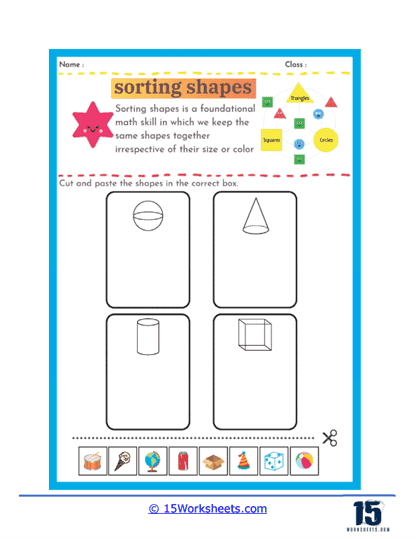Sorting Shapes Worksheets
About These 15 Worksheets
These worksheets help young learners grasp fundamental concepts in geometry. These worksheets typically involve exercises where children cut out various shapes and paste them into designated categories. The primary objective of these activities is to enhance children’s ability to recognize, differentiate, and categorize geometric shapes based on their properties. Sorting shapes is a foundational math skill that prepares students for more advanced topics in mathematics and spatial reasoning.
Benefits of Sorting Shapes Worksheets
Sorting Shapes worksheets offer numerous benefits to young learners. By engaging in these activities, children develop several key skills that are essential for their academic growth. Here are some of the primary benefits:
Visual Discrimination
One of the main benefits of Sorting Shapes worksheets is the development of visual discrimination skills. These skills enable children to notice differences and similarities between shapes, which is crucial for reading, writing, and mathematical problem-solving. By sorting shapes, students learn to identify distinctive features such as the number of sides, angles, and overall form.
Fine Motor Skills
Cutting and pasting shapes require precise hand movements, which help in developing fine motor skills. These skills are important for daily tasks such as writing, buttoning clothes, and using utensils. Engaging in these activities strengthens the muscles in the hands and fingers, improving dexterity and coordination.
Critical Thinking and Problem-Solving
Sorting shapes encourages children to think critically and solve problems. They need to decide which category each shape belongs to, which involves analyzing and comparing different shapes. This process enhances their ability to make decisions and solve problems systematically.
Spatial Awareness
Understanding and recognizing shapes help children develop spatial awareness. This skill is crucial for navigating the world around them and understanding the relationship between objects in space. Sorting shapes worksheets often include exercises that require children to manipulate shapes, further enhancing their spatial reasoning abilities.
Types of Exercises
Sorting Shapes worksheets include a variety of exercises and practice problems designed to engage students and reinforce their understanding of geometric concepts. Here are some common types of activities found in these worksheets:
Basic Shape Sorting – In basic shape sorting exercises, children cut out simple shapes such as circles, squares, triangles, and rectangles and paste them into the correct categories. These exercises are designed for beginners and help students recognize and differentiate between basic geometric shapes.
Color Sorting – Color sorting activities combine shape recognition with color identification. Students sort shapes not only based on their form but also their color. For example, they might sort red circles, yellow triangles, green squares, and blue rectangles into corresponding color-coded boxes. This exercise enhances both color and shape recognition.
3D Shape Sorting – More advanced worksheets may include 3D shapes such as spheres, cubes, cones, and cylinders. Students cut out these shapes and sort them into categories based on their three-dimensional properties. This activity introduces children to basic concepts of 3D geometry and helps them understand the differences between flat and solid shapes.
Venn Diagrams – Some sorting shapes worksheets use Venn diagrams to teach children about set theory and logical classification. Students move shapes into different sections of the Venn diagram based on specific attributes, such as color, size, or number of sides. This exercise enhances critical thinking and helps students understand the concept of intersections and unions in sets.
Pattern Recognition – Pattern recognition exercises involve sorting shapes based on repeating patterns. Students identify and continue patterns by sorting shapes into the correct sequence. This activity strengthens their ability to recognize patterns, an important skill in both mathematics and everyday life.
Matching Shapes – In matching shape exercises, children draw lines to connect shapes with their corresponding names or categories. For example, they might match the word “circle” with an image of a circle. This activity reinforces shape vocabulary and helps students associate geometric terms with their visual representations.
Real-World Applications – To make learning more relatable, some worksheets include real-world applications of shape sorting. Students might sort pictures of everyday objects based on their shapes, such as sorting a pizza slice (triangle), a ball (circle), and a book (rectangle). This exercise helps children understand how geometric shapes are present in their surroundings.
Real World Examples and Careers
Sorting shapes is a skill that extends beyond the classroom and into various real-world applications. Many careers and everyday tasks require the ability to recognize, categorize, and manipulate shapes. Here are a few examples:
Construction and Architecture
In construction and architecture, sorting different geometric shapes is crucial for both design and structural integrity. Architects and engineers must categorize shapes to ensure that building components fit together properly and distribute weight evenly. For example, triangular shapes are often used in trusses and bridges due to their ability to distribute force and provide stability. Rectangles and squares are used for rooms and structural components, providing uniformity and ease of construction. Understanding how to sort and apply these shapes ensures that buildings are both aesthetically pleasing and structurally sound.
Manufacturing and Industrial Design
In manufacturing and industrial design, sorting geometric shapes is essential for creating parts that fit together efficiently. Many products are made up of multiple geometric components that must be precisely shaped and sorted to ensure they function correctly. For instance, gears, bolts, and machine parts often require specific geometric shapes to operate smoothly. Sorting these shapes helps in quality control and assembly line efficiency, ensuring that each part meets the required specifications and fits together without issues.
Computer Graphics and Animation
In computer graphics and animation, sorting geometric shapes is fundamental for creating realistic and visually appealing scenes. Objects in digital environments are often composed of basic geometric shapes that are sorted and manipulated to form complex models. For example, animators use polygons to construct 3D models of characters, environments, and objects. Sorting these shapes correctly allows for smooth rendering and animation, making digital scenes more lifelike and dynamic.
Robotics and Automation
Robotics and automation rely heavily on the sorting of geometric shapes to perform tasks accurately. Robots often use sensors and algorithms to identify and sort objects based on their shapes. This capability is crucial in various applications, such as sorting packages in warehouses, assembling parts in manufacturing, and performing surgical procedures in medicine. By accurately sorting geometric shapes, robots can carry out tasks with precision, efficiency, and minimal human intervention.
Urban Planning and Landscaping
Urban planning and landscaping involve sorting geometric shapes to create functional and aesthetically pleasing spaces. Planners use geometric shapes to design layouts for parks, streets, and public spaces, ensuring that areas are accessible and well-organized. In landscaping, sorting shapes helps in designing garden layouts, walkways, and other outdoor features. For example, circular and curved shapes might be used for aesthetic garden beds, while rectangular shapes might be used for paths and patios. Proper sorting of these shapes ensures that urban and outdoor environments are both practical and visually appealing.
Education and Cognitive Development
In education, sorting geometric shapes is a fundamental activity that supports cognitive development and spatial reasoning in children. Activities involving sorting shapes help children recognize patterns, understand relationships between different forms, and develop problem-solving skills. These activities are often integrated into early childhood education to build a strong foundation in geometry and mathematics. Sorting shapes also enhances fine motor skills and hand-eye coordination as children manipulate and categorize different objects.
Art and Design
In art and design, sorting geometric shapes is essential for creating balanced and harmonious compositions. Artists and designers use a variety of geometric shapes to construct patterns, layouts, and visual elements. For instance, graphic designers sort shapes to create logos, posters, and digital art, ensuring that each element contributes to the overall aesthetic. In fine arts, sorting and arranging geometric shapes can create abstract art, where the interplay of forms and spaces generates visual interest and meaning.
Healthcare and Medical Imaging
In healthcare, sorting geometric shapes plays a role in medical imaging and diagnostics. Techniques such as MRI, CT scans, and X-rays produce images that healthcare professionals must interpret by identifying and sorting different shapes within the body. Recognizing geometric shapes helps in diagnosing conditions, planning surgeries, and understanding anatomical structures. For example, sorting the shapes of bones, organs, and tumors from imaging results allows for accurate assessment and treatment planning.
Logistics and Packing
In logistics and packing, sorting geometric shapes is crucial for optimizing space and ensuring safe transport of goods. Packaging designers use geometric principles to create boxes and containers that maximize space efficiency while protecting products. In warehousing, sorting shapes helps in organizing inventory and optimizing storage. For instance, knowing how to stack cylindrical barrels or rectangular boxes can significantly impact storage capacity and accessibility.
Navigation and Cartography
In navigation and cartography, sorting geometric shapes is essential for map-making and spatial orientation. Geometric shapes represent different features on maps, such as roads, buildings, and natural landmarks. Sorting these shapes accurately ensures that maps are easy to read and interpret. In navigation, understanding geometric relationships between locations helps in planning routes and understanding spatial relationships in the real world.





